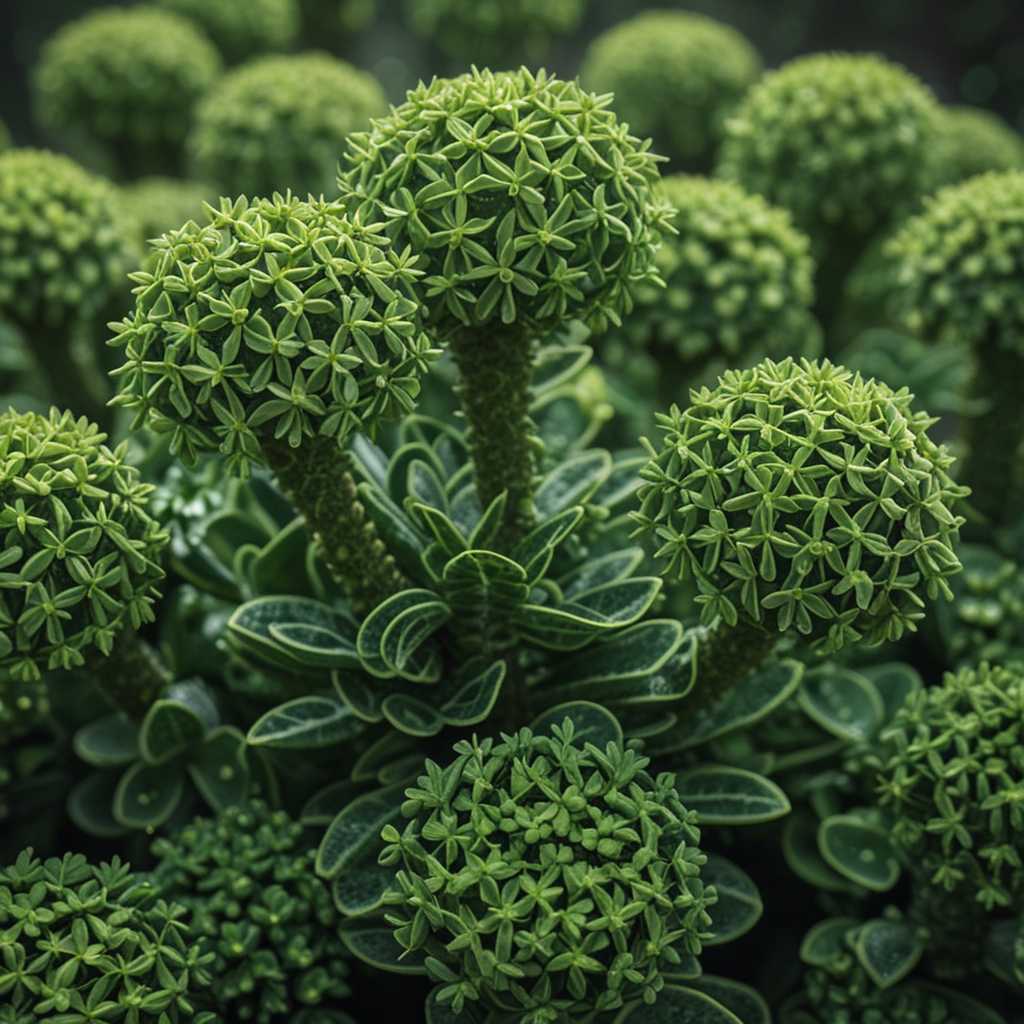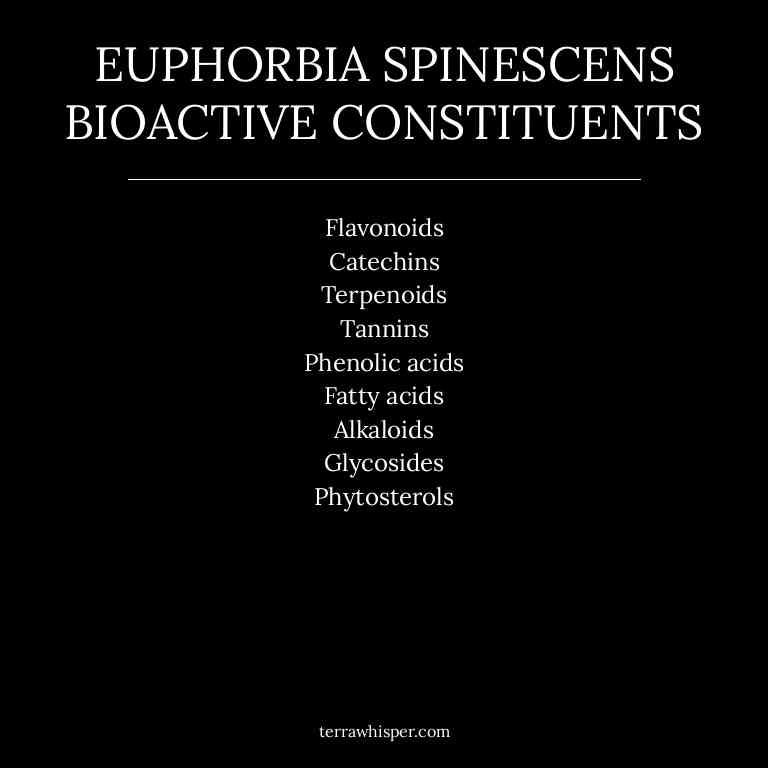Euphorbia Spinescens Uses, Benefits, And Remedies

Euphorbia spinescens, commonly known as the spiny euphorbia, is a flowering plant native to parts of Africa, characterized by its distinctive spiny stems and yellow sap.
This herb is traditionally used for its anti-inflammatory and antimicrobial properties, which may support skin health and immune function.
The bioactive constituents include alkaloids, flavonoids, and tannins, which contribute to its therapeutic actions.
Herbal preparations such as infusions, poultices, and tinctures can be made from the leaves and stems for various medicinal purposes.
This page analize the most important medicinal aspects of Euphorbia spinescens.
- Health Benefits
- Bioactive Constituents
- Medicinal Parts
- Herbal Preparations
- Side Effects of euphorbia spinescens
Health Benefits
Euphorbia spinescens fights cancer cells by containing bioactive compounds such as flavonoids and alkaloids, which have been shown to induce apoptosis in malignant cells and inhibit tumor growth through the modulation of signaling pathways involved in cell proliferation and survival.
It reduces oxidative stress by acting as a potent antioxidant, neutralizing free radicals and enhancing the body's natural antioxidant defenses, which helps prevent cellular damage and chronic diseases. It treats wounds faster due to its anti-inflammatory and antimicrobial properties, which promote tissue regeneration and prevent infection during the healing process. It treats infections by inhibiting the growth of pathogenic bacteria and viruses, thanks to its phytochemical composition that disrupts microbial cell membranes and interferes with their replication mechanisms.
It fights fungal infections by containing compounds that inhibit fungal enzyme activity and disrupt the cell wall structure of fungi, thereby preventing their spread and promoting recovery.
The 10 best health benefits of Euphorbia spinescens are shown in the image below.

The list below give a brief description of the 10 best health benefits of Euphorbia spinescens.
- Fights Cancer Cells: Euphorbia spinescens contains compounds that may inhibit the growth of cancer cells by inducing apoptosis and disrupting cell proliferation.
- Reduces Oxidative Stress: The herb is rich in antioxidants that help neutralize free radicals, thereby reducing oxidative stress in the body.
- Treats Wounds Faster: Euphorbia spinescens has antimicrobial and anti-inflammatory properties that promote faster healing of wounds.
- Treats Infections: The herb exhibits broad-spectrum antimicrobial activity, making it effective against various types of infections.
- Fights Fungal Infections: Euphorbia spinescens contains natural antifungal compounds that help combat fungal infections effectively.
- Fights Bacterial Infections: The herb possesses antibacterial properties that can help eliminate harmful bacteria and prevent infections.
- Soothes Digestive Issues: Euphorbia spinescens may help alleviate digestive problems by reducing inflammation and improving gut health.
- Cures Eye Infections: The herb's antimicrobial and anti-inflammatory properties can help treat eye infections when applied topically.
- Reduces Inflammation: Euphorbia spinescens contains compounds that help reduce inflammation throughout the body, easing symptoms of various inflammatory conditions.
Bioactive Constituents
Euphorbia spinescens flavonoids are a group of bioactive compounds known for their antioxidant and anti-inflammatory properties, which contribute to the plant's medicinal value.
These flavonoids help neutralize free radicals in the body, reducing oxidative stress and potentially preventing chronic diseases. In addition to flavonoids, Euphorbia spinescens contains catechins, which are also potent antioxidants that support cardiovascular health and may aid in weight management.
The herb also includes terpenoids, a diverse class of compounds with antimicrobial, anti-cancer, and immune-modulating effects, making them valuable in traditional and modern medicine. Furthermore, tannins present in Euphorbia spinescens exhibit astringent properties, which can help in treating gastrointestinal issues and skin conditions.
Together, these medicinal constituents highlight the plant's potential as a natural remedy for various health conditions, although further research is needed to fully explore their therapeutic applications.
The 9 best bioactive constituents of Euphorbia spinescens are shown in the image below.

The list below give a brief description of the 10 best bioactive constituents of Euphorbia spinescens.
- Flavonoids: Flavonoids are a group of plant compounds known for their antioxidant properties, which help protect cells from damage caused by free radicals.
- Catechins: Catechins are a type of flavonoid with strong antioxidant properties, often found in plants and known for their potential health benefits.
- Terpenoids: Terpenoids are a large and diverse class of organic compounds produced by a variety of plants, often with antimicrobial and anti-inflammatory properties.
- Tannins: Tannins are a group of polyphenolic compounds that can bind to proteins and are known for their astringent properties and potential health benefits.
- Phenolic Acids: Phenolic acids are organic compounds with antioxidant properties that may help reduce inflammation and protect against cellular damage.
- Fatty Acids: Fatty acids are essential components of cell membranes and play a crucial role in energy storage and signaling within the body.
- Alkaloids: Alkaloids are naturally occurring compounds that often have potent physiological effects on humans and animals, including medicinal and toxic properties.
- Glycosides: Glycosides are compounds consisting of a sugar molecule bonded to a non-sugar component, often having medicinal properties such as cardiac or antispasmodic effects.
- Phytosterols: Phytosterols are plant-derived compounds that are structurally similar to cholesterol and may help lower blood cholesterol levels and support cardiovascular health.
Medicinal Parts
Euphorbia spinescens leaf is one of the primary medicinal parts used in traditional medicine, known for its potent anti-inflammatory and analgesic properties.
The leaves contain various bioactive compounds, including alkaloids, flavonoids, and terpenoids, which contribute to their therapeutic effects. In traditional African medicine, the leaf is often applied topically to treat skin infections, wounds, and inflammatory conditions such as arthritis.
It is also used to alleviate pain and reduce swelling in various ailments. The stem of Euphorbia spinescens is another important part, containing similar bioactive compounds and is used similarly to the leaf, though it may have a more pronounced effect due to its higher concentration of certain compounds. The fruit, while less commonly used, is sometimes employed in herbal preparations for its potential antispasmodic and digestive properties.
Overall, the leaf, stem, and fruit of Euphorbia spinescens are valued for their diverse medicinal applications, though their use requires caution due to the plant's toxicity.
Herbal Preparations
Euphorbia spinescens tinctures are commonly prepared by soaking the dried plant material in alcohol to extract its active compounds, making them a popular choice for topical and internal use.
These tinctures are often used to treat skin conditions, such as warts and eczema, due to their potent anti-inflammatory and antimicrobial properties. The concentrated nature of tinctures allows for precise dosing, which is beneficial for both traditional and modern herbal practitioners.
In addition to tinctures, Euphorbia spinescens can be made into decoctions by boiling its roots or leaves, which are typically used for digestive support and to reduce inflammation. Capsules and oils are also common forms, with capsules offering a convenient way to consume the herb internally, while oils are often used for massage or as a base for topical applications.
Each preparation method highlights the versatility of Euphorbia spinescens in herbal medicine, allowing for tailored use based on the desired therapeutic effect.
The 10 best herbal preparations of Euphorbia spinescens are shown in the image below.

The list below give a brief description of the 10 best herbal preparations of Euphorbia spinescens.
- Tinctures: Tinctures of Euphorbia spinescens are used to support digestive health and are believed to aid in the treatment of intestinal parasites.
- Decoctions: Decoctions of Euphorbia spinescens are traditionally used to treat skin conditions and are believed to have anti-inflammatory properties.
- Capsules: Capsules of Euphorbia spinescens are used to support liver function and are believed to help with detoxification processes in the body.
- Oils: Oils extracted from Euphorbia spinescens are applied externally to treat wounds and are believed to have antimicrobial and healing properties.
Side Effects of euphorbia spinescens
Euphorbia spinescens skin burn is a common and severe reaction caused by the plant's toxic sap, which contains irritants and caustic compounds.
Contact with the plant's latex can lead to immediate skin irritation, including stinging, burning, and blistering sensations. The sap may cause painful skin rashes, redness, and even open blisters that can take days to heal. In more severe cases, the irritants can spread to the eyes, causing significant eye irritation, redness, and potential corneal damage.
It is crucial to avoid direct contact with the plant and to seek medical attention if severe symptoms develop, as the effects can be quite intense and prolonged.
The 7 most common side effects of Euphorbia spinescens are shown in the image below.

The list below give a brief description of the 7 most common side effects of Euphorbia spinescens.
- Skin Burn: Contact with the Euphorbia spinescens herb can cause a chemical burn due to the presence of irritant compounds in its sap.
- Sting Skin: The herb's spines and sap can cause a stinging sensation upon contact with the skin, leading to discomfort and irritation.
- Skin Blister: The irritant properties of the herb can lead to the formation of blisters on the skin as a defensive reaction.
- Skin Rash: Exposure to the herb may result in a rash, characterized by redness, itching, and inflammation of the skin.
- Pain Skin: The herb can cause pain on the skin due to its irritant compounds, which may lead to a burning or prickling sensation.
- Blister Skin: The sap of Euphorbia spinescens can cause blisters to form on the skin, often accompanied by pain and swelling.
- Eyes Irritate: Contact with the herb's sap can irritate the eyes, causing redness, tearing, and a burning sensation.